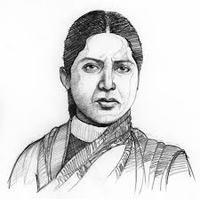(Krupabai Sattiyanadhan was a Hindu converted to Christianity before birth. She started a school for Muslims which is still running in Kandhal, Ooty. She was a doctor and a novelist who was the one of the earliest to write about women’s liberation. Her husband was the first India Headmaster of Breeks Memorial School, Ooty)
Krupabai was born in 1862 to Hindu converts to Christianity in Ahmednagar. She lost her father and her brother when she was still a child. Two European missionary ladies took charge of her and her education. One was Mrs. Grigg, the wife of H.B. Grigg, the author of the Manual of the Nilgiris District.
At a boarding school in Bombay, she met an American woman doctor who got her interested in medicine. She won a scholarship to go to England but her failing health prevented it. However, the Madras Medical College agreed to admit her in 1878, and she became a boarder at the house of the Reverend W.T. Satthianadhan, a well known Christian missionary.
She married Samuel Satthianadhan, the Reverend’s son in 1881. Soon after, Samuel got a job as Headmaster of Breeks Memorial School in Ootacamund (the old school in the present court house). In Ooty she started a school for Muslim girls with help from the Church Missionary Society which is still running. She also wrote under the byline ‘An Indian Lady’. One of the articles was “A Visit to the Todas”, published in Ootacmund in South India Observer.
From Ooty they moved to Rajamundry and Kumbakonam. By the time they returned permanently to Madras in 1886 she was ready to begin a full-scale novel, Saguna, which was serialized between 1887 and 1888 in the Madras Christian College Magazine.
However, during this time her only child died before reaching its first birthday and she was plunged into depression. She was also diagnosed of terminal tuberculosis. Knowing that she had little time to live, she began work on Kamala. She worked continuously on the book till her death.
A scholarship for women was set up in her memory at the Madras Medical College, and a memorial medal at the University of Madras. Her novels were published as books and translated into Tamil.
Kamala was mostly written in Coonoor, ‘with its healthy air’ and ‘enjoying the scenery of the mountain heads high in the land of eternal rest’. She finished Kamala in “a feverish fear she might not live to complete it”.
Of her last days, her husband says,’ Krupabai and her sister-in-law Joanna Satthianadhan were staying in Coonor in the summer 1894. Joanna was nursing Krupabai who was bedridden. Three weeks after their return to Madras Joanna was taken ill with typhoid and died after two weeks. Three days later, on August 3rd, Krupabai “was called to her rest”. Her memorial stone read “India’s First Lady Novelist”.
In 1889 Samuel Satthianadhan married a young woman with a B.A. from the Madras University who changed her first name to “Kamala” according to a Hindu marriage tradition. Samuel died in 1906.
Nilgiri Documentation Centre

